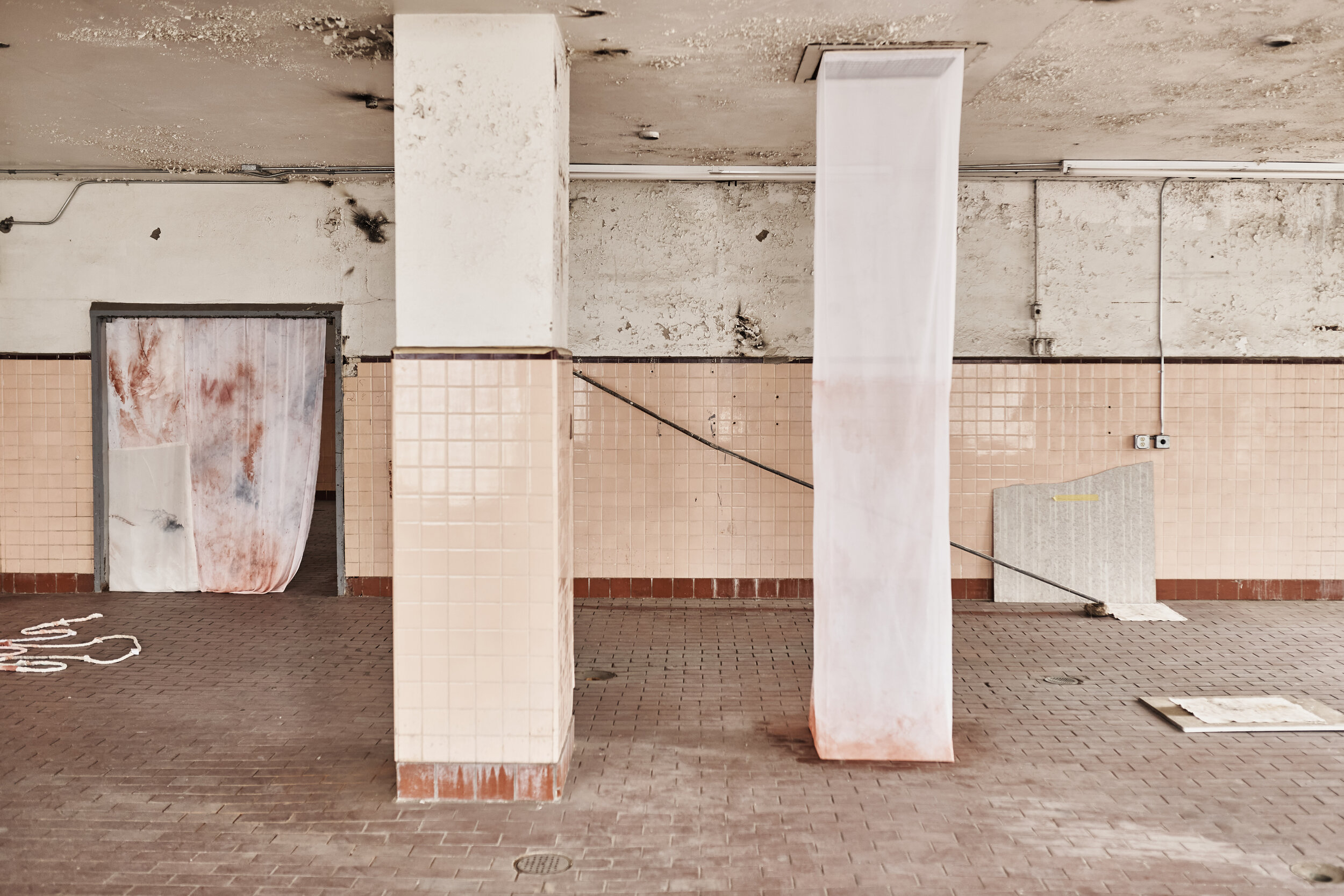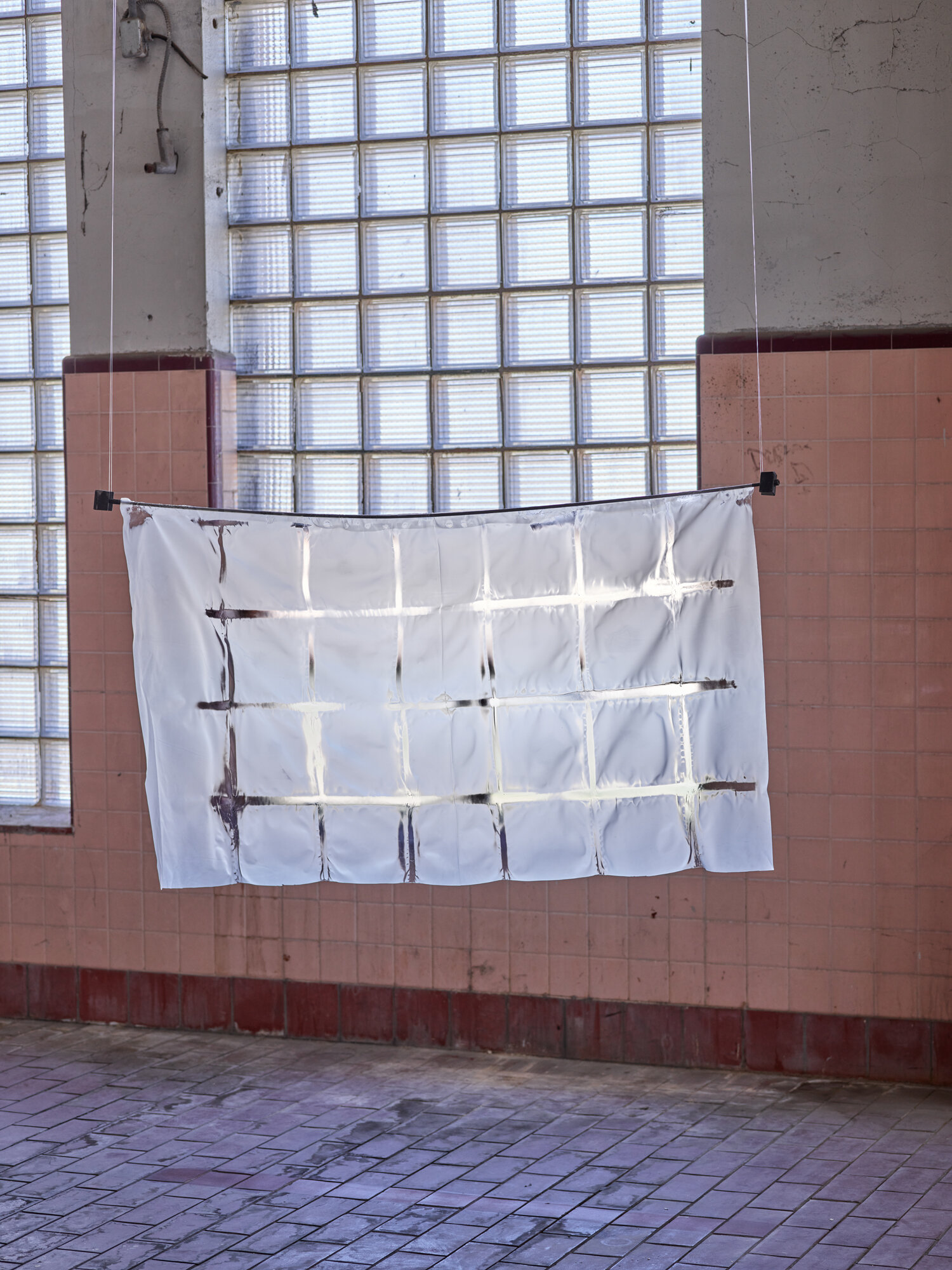FLESH & BONE
Cedars Union, Boedeker Building, Dallas, TX, 2021
This work is the culmination of on-site research made during the months of November and December 2020 in the historic Boedeker Building in Dallas, TX. Built in 1921, the Boedeker Building bears the name of the company that was founded in 1887 by German, Frederick Boedeker, the first ice cream manufacturer in Dallas. In Flesh & Bone, Jaeggli considers the living body in relationship to the building’s history and the inhabited world. All that remains of this 100-year-old former ice cream factory are the “bones" made from calcium carbonate materials, the same substance that makes up our own bones. The installation is made up of small and large moments created using translucent fabric, rope, vinyl, found objects, and paintings created from the building’s dust, paint flakes and dirt as pigment. The work is a meditation on the connective tissue between our bodies, time, and the world. It is a reflection on how our experience on earth is temporary, porous and visceral.
Column
This fabric column was the first thing I envisioned making in this space at the Boedeker Building. I loved the idea of this single column holding up the room. The quiet strength and longevity reminded me of my mother, and her mother before that. Strong women who held it together so the rest wouldn’t fall apart. I wanted to echo that with this piece, point to the life that was lived in this room, and draw attention to elements that we take for granted. The interior column’s functionality vs. an exterior column’s decorative purpose.
DUST PAINTINGS
Part of the work I made onsite were paintings made from the dust, dirt, found paint flakes, on-site debris, on canvas. Dust is made of human skin cells and building particles alike. I wanted to make these works to make a connection between present day and time past. This one is called “Shroud”. A shroud is a cloth that covers or protects some other object, and is usually used in reference to burial sheets or grave clothes (think Shroud of Turin). I wanted to capture the sink and everything it symbolizes with this painting. This was one remaining item in the room through which I felt intimately connected to the people who had occupied the space before me — workers in an ice cream factory, washing their hands here. The sink had a secondary meaning for me during this time of intense hand washing and hygiene. Attempting to clean a functionless object that would likely end up in a dumpster felt like preparing a body for burial.
INVESTIGATING THE BODY OF THE BUILDING
This piece began as most of the Flesh & Bone works did — as responses to the building. I was thinking a lot about the components in the room that once held important functionality, like this electrical conduit. No longer conveying electricity, this metal line became a drawing in space, and memory of vitality, that I wanted to play with. To make it, I used one of my husband’s old sailing ropes and wrapped it with fabric: torn bedsheets and pillow cases from our bed and repurposed paintings of mine. I let the resulting piece do what it wanted to do on the floor, making another drawing. I also used this rope to gently guide visitors toward the installation when they arrived on the 3rd floor.
Milk
This piece was meant to bring attention to the original functionality of the room — the mixing room of an ice cream factory. This was where milk turned into ice cream. Milk is our first drink, and as a mother, it has played an important role to me. Again, this elemental substance is another connection between the present and the past.
honoring the space
The Boedeker Building is a vacant building, in a state of decay. It reminded me of time I spent in Berlin after the wall came down, vacant buildings in my hometown of Baltimore. Cities and buildings in limbo, in a state between their past and future. The floors one this building are made of uneven, broken concrete and the dust coating every surface tells a story of time past. It is a very “un-Dallas” building — she is showing you her age, her cracks, her flaws. I wanted to make work that responded to the beauty in age and history.
CLEANING AS ART
To clean a place is to know it. A huge part of this project at the Boedeker was simply cleaning this room to get it to a point where I could make work in it. Covered with years of dust and grime, the floors have been untouched and uncleaned. Having lived in many apartments and houses from Baltimore to NYC to Austin, the first thing I always do is clean. Hours spent in rubber gloves getting to know every corner, drawer, shelf and closet until the space feels like mine. A similar thing happened here at the Boedeker. After shop-vac’ing, sweeping, mopping, scraping and hauling debris, I felt like I had made the space my own, or at least gotten to a point where I knew it intimately. Cleaning as art? Cleaning as performance? I think of the artist Mierle Laderman Ukeles who used cleaning as a foundation for her art.
Stalactite
I have been interested in caves and cave formations for a long time. With this piece, I wanted to draw attention to the role that calcium plays as a connective thread between us and our surroundings. The Boedeker Building was the first poured concrete building in Dallas. Concrete is largely made up of calcium carbonate, the same substance that makes stalactites and also our own bones.
Reflections on my experience
Working on site at the Boedeker Building was truly a gift of a lifetime. It allowed me to slow down, observe, and respond to a space like I have never done before. The work I made there helped crystallize some themes I have been working on in my studio practice, like embodiment and our bodily experience of the world. While these photos are wonderful to have, the experience of meeting with people on-site to view and discuss the work was incredible.





































































